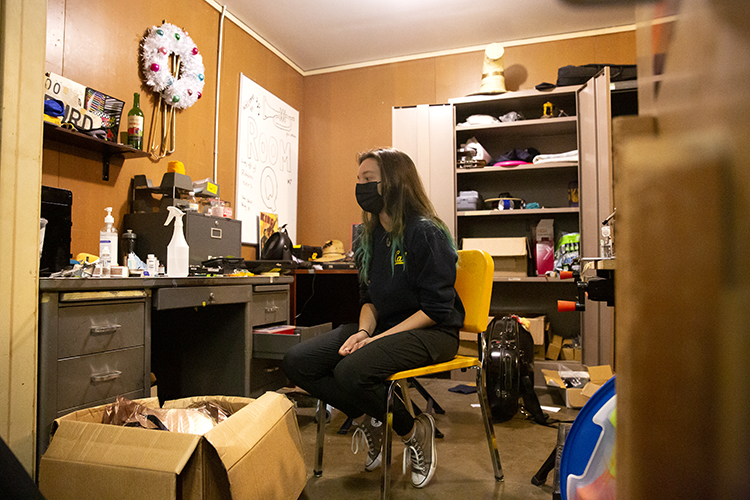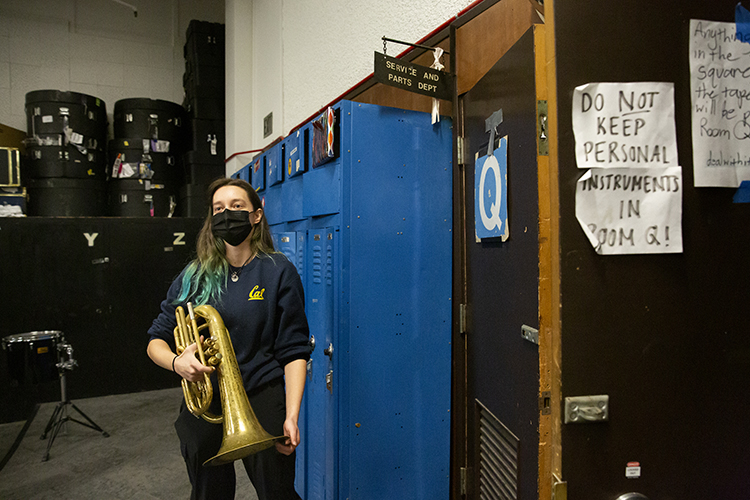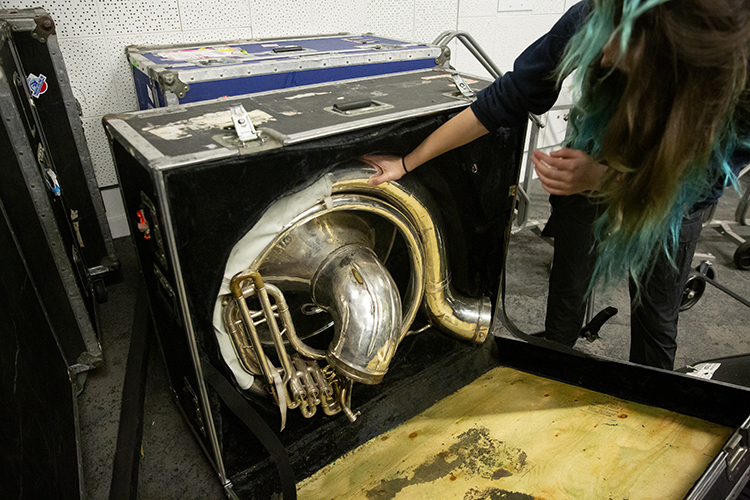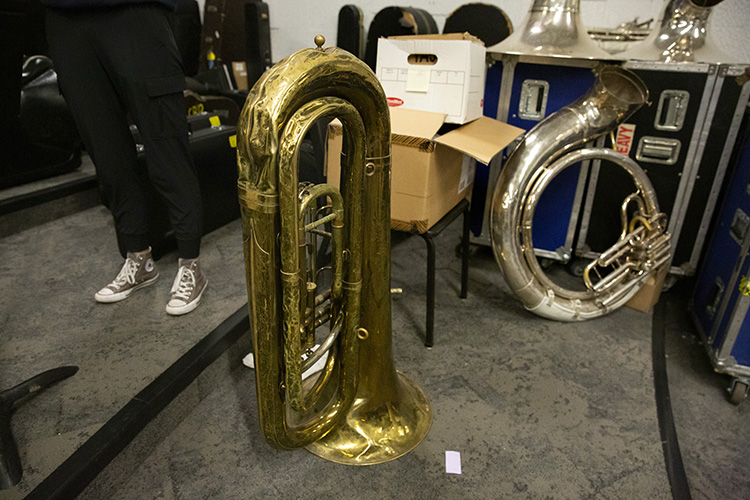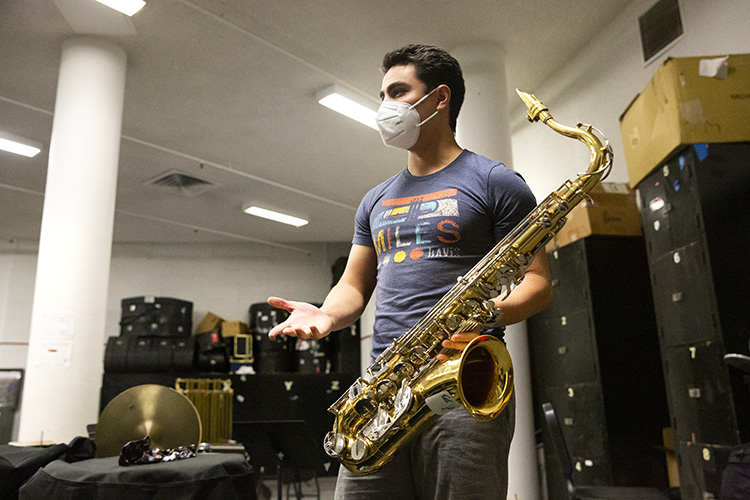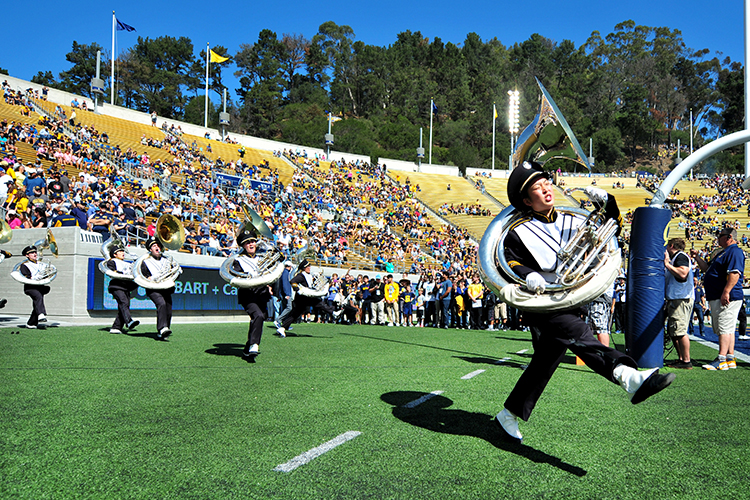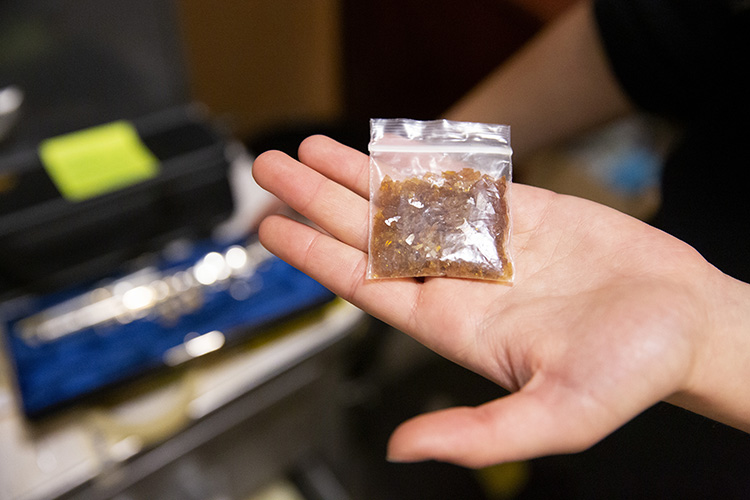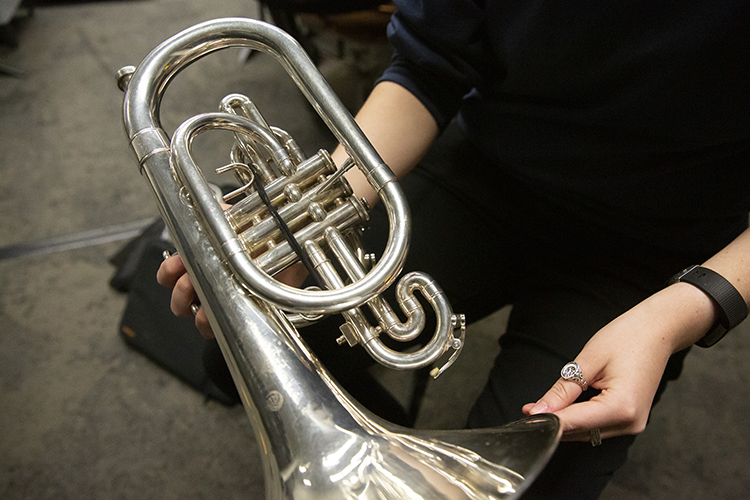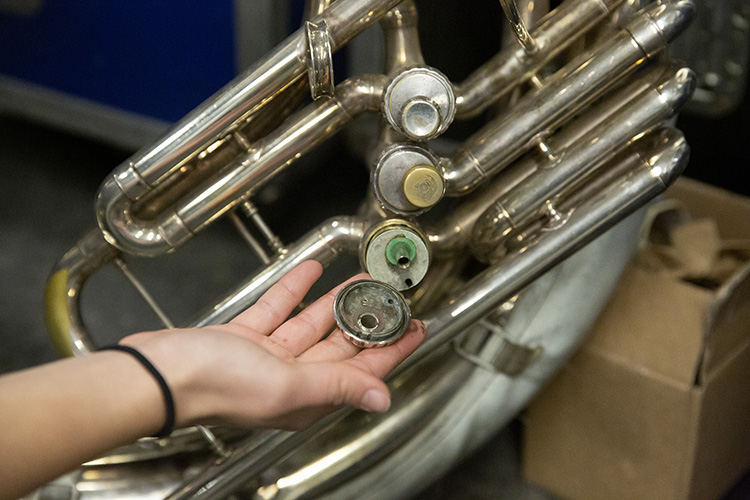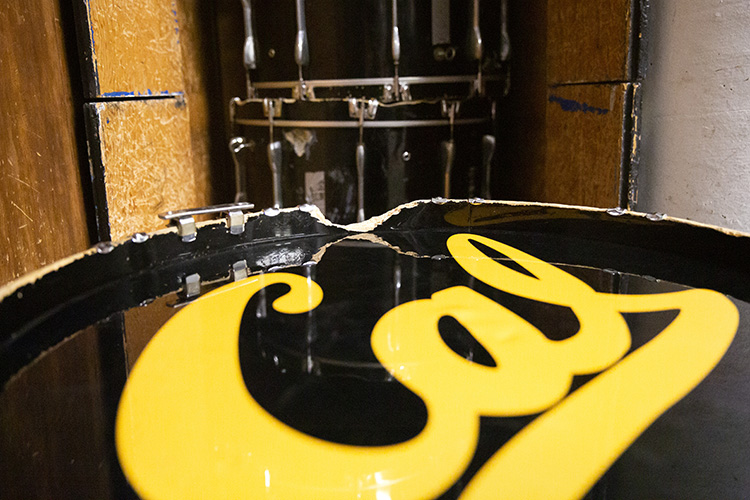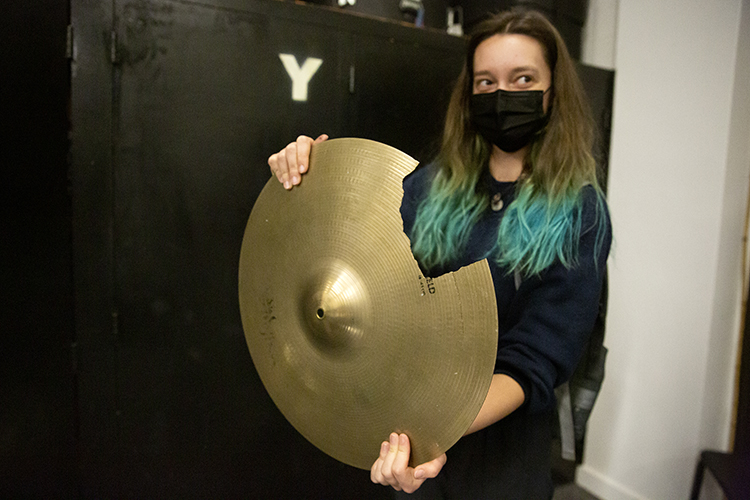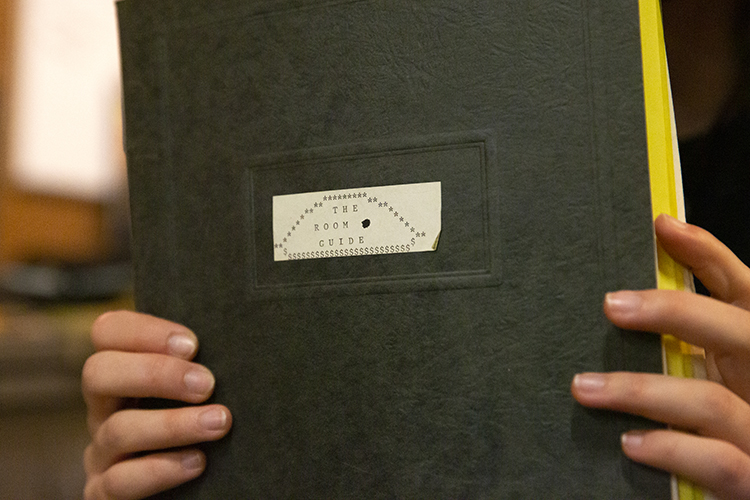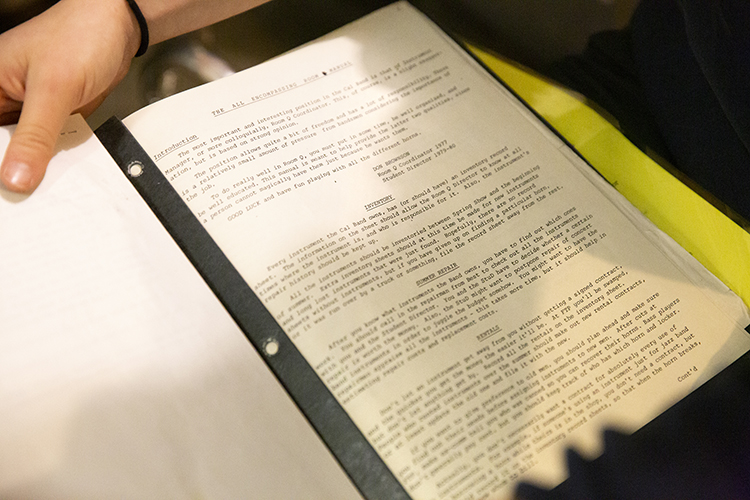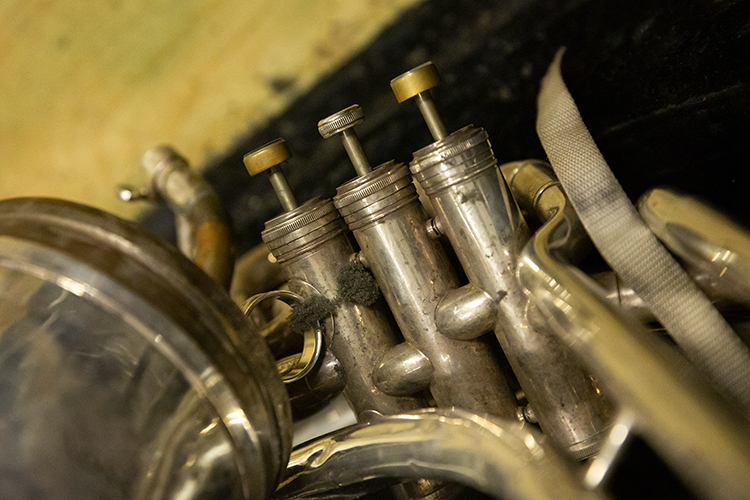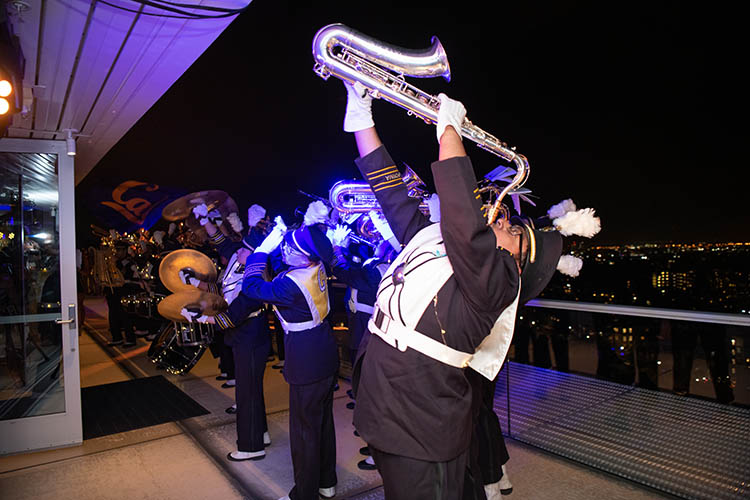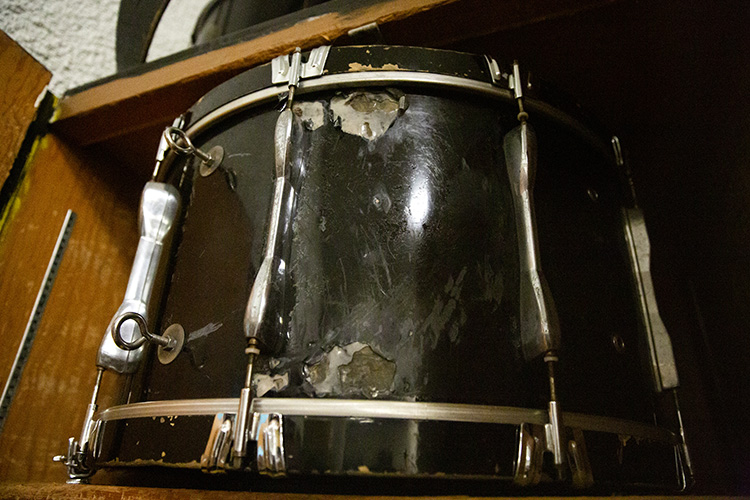A matter of fair play: Cal Band seeks all new instruments
A major fundraising campaign for the aging collection is getting traction
April 18, 2022
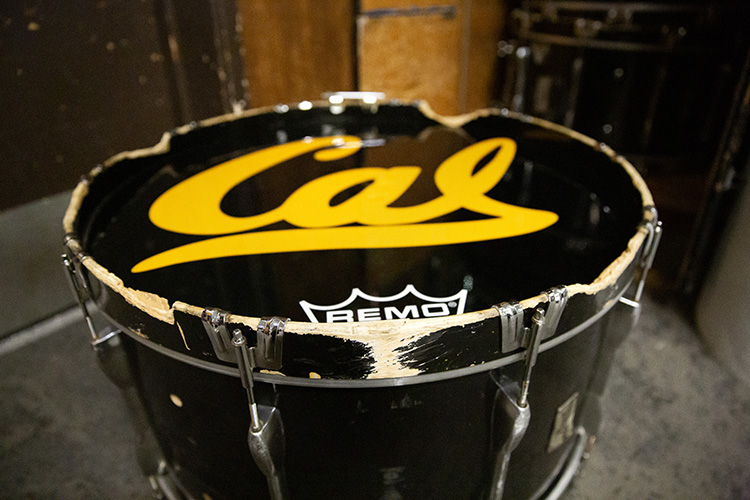
The Cal Band has embarked on an ambitious fundraising project to replace all of its instruments, which are decades old, don’t match and in many cases can no longer be repaired. (Photo by Brittany Hosea-Small)
Room Q is a tiny walk-in clinic, of sorts, for the Cal Band’s broken instruments. There, just off the marching band’s rehearsal hall in the Cesar Chavez Student Center, horns with dented bells, clarinets missing joint corks, beat-up drums, and piccolos lacking key pads are brought for diagnoses and repair.
But like the room’s signage — a giant Q tacked on the door with grey duct tape — most of the aging instruments are patched together there by student volunteers with duct tape, painter’s tape, rubber bands, shellac and used parts. The $650,000 annual budget for UC Berkeley’s historic, primarily student-led band, founded in 1891 and running primarily on donations, can’t stretch to replace its 160 instruments. Nearly all the instruments are decades old and failing more rapidly each year.
“Every instrument we currently own needs to be replaced. One hundred percent of students should be playing on a better instrument,” said Matthew Sadowski, Cal Band’s director since 2018. Many of the 187 students in the band often are performing with “substantially worse” instruments than the ones they played in high school, he said, and miss rehearsals if, or in many cases when, their equipment is broken or in the shop.
The situation also is one of equity and accessibility: Students who can afford to purchase or rent better instruments than the band provides do just that, which leads to an improvement in their musicality and opportunities for student leadership positions, such as section leaders.
“Musicianship is one of the primary prerequisites for getting those positions, and if you don’t have the equipment for a good audition, you won’t have the opportunity,” said Sadowski.
Said clarinet player Layne Fajeau, the band’s public relations director, “We want to see the Cal Band as accessible as it can be to everyone.”
That’s why a daunting fundraising effort has been launched by the band this academic year. It seeks to raise $635,000 for all new, professional-quality instruments, with the goal of boosting the volume and quality of the band’s sound, growing its student ranks and providing an equitable experience for every member.

Cal Band Director Matthew Sadowski says the situation is a matter of equity and accessibility: When the band can’t provide each student with an adequate instrument, not everyone can afford to rent or buy one, and that hurts their chances to grow musically and to compete for student leadership positions. (Photo by Brittany Hosea-Small)
It’s an unnecessary task for most marching bands at Berkeley’s peer institutions, since the bulk of their funding comes from a variety of university departments. The Cal Band today gets $108,000 annually from fees paid by all Berkeley students and $20,000 from Cal Athletics; as a result, band members work thousands of unpaid hours to raise the remaining 77% of what’s needed for the operating budget. In addition, they fundraise to cover additional costs, such as the band’s new $300,000 uniforms — the first they’ve had in 15 years — that will debut at the first home football game next fall.
To buy new instruments, the band has secured nearly $160,000 to date — $133,000 for new sousaphones, or “basses” (bass tubas), $25,000 for piccolos and $1,700 for cymbals. Five new pairs of cymbals and 10 new piccolos arrived last fall. Next fall, 10 to 20 more piccolos and 12 basses will be added.
“In the case of the basses,” said Sadowski, “the donor generously included funding in the $133K that will allow us to give major tune-ups to our existing basses so they can be used as travel instruments and loaned out to alumni for Alumni Band performances.”
Theresa Wilkinson Carey, a Berkeley alumna and retired financial technology reviewer, set up the Pioneer Women’s Fund this past winter to help raise money for new instruments. A 1977 graduate, she joined the Cal Band in 1973, the first year that women were allowed to participate; 23 of the 120 band members that year were women. The year 2023 marks the 50th anniversary of women in the band.
Carey recalled renting a piccolo for $8 a month from an Oakland music shop, since the band had only one; eight new piccolo players joined the band in 1973. Students currently rent instruments from the band for $35 a year, rent them elsewhere or buy used or new ones. This past fall, the band didn’t have enough piccolos, said Sadowski, “so some students had to play the flute until we could borrow a couple piccolos from our alumni.”

Theresa Wilkinson Carey (back row, middle) joined the Cal Band in 1973, the first year it allowed women to take part. She has set up a fund to raise money for new instruments for the band, which has purchased new piccolos, sousaphones and cymbals so far with money provided by several donors. (Photo courtesy of Lindsay Hiratzka)
Angelo Frisina, a first-year student who plays tenor sax in the band and is a director’s assistant, said renting an instrument off campus “is extremely expensive. I could get a nice classical Yamaha tenor sax for about $90 a month. But I can rent (a Cal Band) instrument for $35 per year. … Some have no neck straps, and some are not in great working condition, … but we still rock.”
Carey said her gift was given “to support the current and future members of the band, to make it easier for students to participate. I’d like to see people as broke as I was able to participate. As a student, I barely had $5 a month left over, enough for a sandwich at the Stuffed Inn.” She added that her donation also honors the history of women in the band.
Sadowski described the effort to replace the band’s instruments as “a matter of equity and inclusion, because we’re asking students to rent or buy instruments when they’re also trying to afford housing and food in the Bay Area. They’ve worked hard to get to Berkeley, they audition for the band, and we should give them everything they need — a uniform, an instrument and a backpack so they can represent the university, not just at football and basketball games, but at countless events across campus and beyond.”
Cal Band members currently perform at more than 165 events a year, about 55% of them related to Cal Athletics. They also produce their own halftime shows, book their own travel, recruit and train new musicians, learn to handle minor medical incidents, conduct music and make repairs to their uniforms, as well as to their instruments.

A brand new piccolo (right) is among many that are being purchased with donor funding. A broken piccolo in Room Q is on the left. (Photo by Brittany Hosea-Small)
One of a handful of students staffing Room Q is Ioana Ana, who plays the mellophone, a brass instrument similar to a French horn. She said she benefits from notes left by former band members in Room Q who, like her, have tried to repair Cal Band instruments quickly and affordably. Some of their advice is contained in the pages of binders kept from the 1970s and ‘80s.
“When we determine that instruments are dead, that’s a problem, because even if only one or two people needed them, these students don’t have their own, and it’s one less person able to play,” said Ana. “We do our best, but the instruments aren’t going to last.”
When asked about their plight, band members are more upbeat than one would expect, given the condition of the instruments and the countless hours they devote to the band while attending school. Some also hold jobs on or off campus to help pay their college expenses.
“The important part of band is always the community; it doesn’t matter if our instruments are shiny and new, or particularly old,” said Keira Colleluori, a fourth-year student who also plays the mellophone. “What I gather is that a lot of people come in (to Cal Band) for the personal connections, and that that’s the most important thing to them.
“It’s frustrating to not have a nice instrument, but it’s not a deal breaker.”

A repair kit in Room Q holds clarinet and saxophone replacement pads, as well as some replacement water key corks for brass instruments. But the band’s needed so many that the box is nearly empty. (Photo by Brittany Hosea-Small)
Still, she continued, “just because it’s not a deal breaker, it’s still a very known frustration when your instrument breaks, and you have to take it to Room Q to get it fixed, or have it taken elsewhere to get it fixed. And if we want new people to come into the band and learn new skills and meet new people, if there’s a barrier of not having a quality instrument to learn on, you can’t imagine how frustrating it would be.”
This semester, Sadowski and student band leaders are meeting with campus officials seeking strategies about how to engage donors and other stakeholders to meet their financial needs.
Fajeau, the band’s public relations director, said he’s had a much better experience with his instrument than most Cal Band members because he owns it. Yet, he admitted, it’s “a middle school-level plastic clarinet that’s over a decade old that I routinely have to get repaired.”
Sadowski might call Fajeau’s clarinet an ISO, an “instrument-shaped object,” he said, which “is not reparable or made by a reputable company, and there is no number to call for parts. In some cases, those instruments break frequently, and we don’t have endless funds to repair them.”
And not everything can be fixed by students working in Room Q. “Instrument repair,” said Sadowski, “is a long-term, master apprentice profession.”
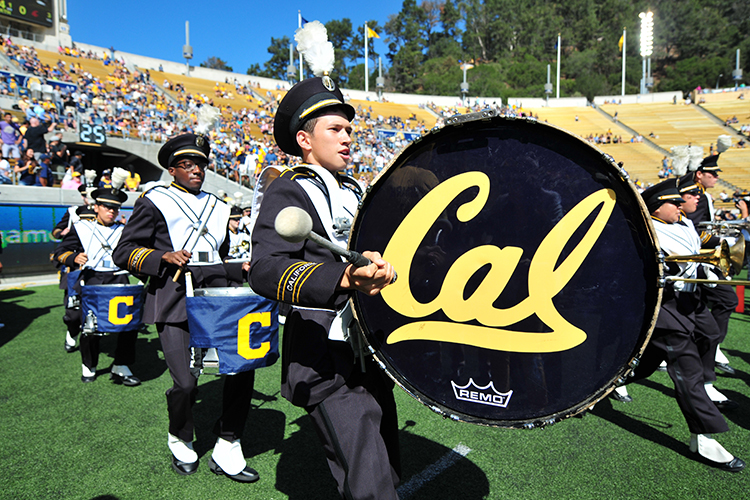
The Cal Band drums up energy for football fans at a Homecoming game. (UC Berkeley photo by Keegan Houser)
Sadowski said he hopes that the Cal Band can someday provide its musicians with instruments that match in looks and quality and that are made by companies that can provide quality parts and service.
For many years, the fact that the band is student-led and operates, in large part, through its own fundraising efforts was “a point of pride for many,” said Sarah Parkes, a fourth-year student and the band’s senior manager, who plays a baritone — or “bearitone,” as she calls it.
“I’m proud to be part of a band that does so much with so little. The fact that our sound and spirit is comparable in quality to that of other well-funded bands is a testament to the strength of our student leadership and how much each individual in this band overcomes challenges,” she said.
One football Saturday, a big challenge arrived. Two basses broke as the band marched from Sather Gate to the stadium, “and they weren’t even being played,” said Parkes. Samantha Kwan, a member of the band’s student activities committee, rushed back to campus, grabbed two more, then lugged them onto the field on her shoulders.
That’s how much band members love the Cal Band.
Still, said Parkes, “no matter how much we love this band, love will not get us playable instruments. We need donations.”
